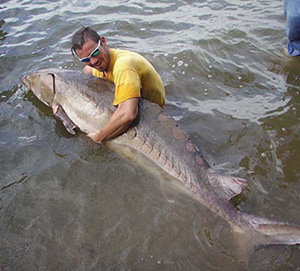WAYNE CREED
Great Atlantic Sturgeon Making Comeback

One of the first sturgeon caught in the James River in decades, this specimen measured over 7 feet long and weighed 300 pounds. (Photo: Virginia Commonwealth University)
By WAYNE CREED
November 10, 2014
In 2012, the National Marine Fisheries Service listed the Great Atlantic Sturgeon under the Endangered Species Act. This is usually bad news, but since sightings and spawning grounds were so rare, the fact that there was enough sturgeon left to even warrant the declaration is a good thing. Two years later, we find that they are once again spawning in the Chesapeake Bay just outside the James River.
A bit of a homecoming, the fish was critical to the first English settlement at Jamestown, and was noted by inhabitants as the “founding fish.” Historians and archaeologists unearthing the history of the Jamestown colony have called the sturgeon “The fish that saved Jamestown.” During a period known as “The Starving Time,” it was the one food source available to the English colonists that kept them alive. Because of their familiarity with the sturgeon species from the Thames River in England, they knew how to catch and cook the fish.
CONTINUED FROM FIRST PAGE
The great sturgeons were also a part of the culture, legend and lore of the Native American tribes along the Chesapeake. The capture of a great sturgeon was not only a source of food, but also a way for young warriors to prove their bravery. Accounts by European colonists in Jamestown described a rite of passage observed in the Powhatan tribe in which men would attempt to ride the back of an adult sturgeon in the James River. Not sure how well that worked out, but given the amount of protein in the fish, its arrival in the tributaries of the Chesapeake was always considered an important event.
Sometimes referred to as prehistoric (they have retained many primitive characteristics, such as the bony skin plates, and may look much the way they looked like during the age of the dinosaurs), sturgeon date back to the Mesozoic Era — 65-230 million years ago. Atlantic sturgeon can live 60 years, grow up to 14 feet, and weigh around 800 pounds. Their prized flesh and caviar roe led to centuries of over fishing. That, along with pollution and destruction of habitat, eliminated sturgeon from many Chesapeake Bay tributaries. Prior to 1890, when a sturgeon fishery began, it was estimated that approximately 20,000 adult females inhabited the Chesapeake Bay.
The recent uptick in activity may only be cyclical, and this has led scientists and researchers to rush to find out what is causing the recovery so that future measures can be put in place to keep it going. NOAA, through the Species Recovery Grants (Protected Species Cooperative Conservation Grants) awarded the Maryland Department of Natural Resources and the Virginia Department of Game and Inland Fisheries $1.7 million to help accelerate the effort.
One of the main issues facing marine researchers is finding the elusive spawning grounds; sturgeon spend most of the time at sea, usually off the shelf banks (they plow the bottom with their snouts, eating worms and crustaceans), but like Rockfish, return to rivers and streams to spawn. This funding from the Protected Species Cooperative Conservation Grants will allow researchers to tag the fish with transponders so that they can track their movements in and around the bay.
The tagging began in 2012 and has been undertaken by Virginia Commonwealth University. Using a small acoustic device that sends off a coded sound (each tag has a unique signature, like an EZPass), the signal is recorded when the fish passes within range of one of the receivers. One of the hurdles to the process is the size of the Chesapeake. The mouth of the Bay alone is 20 miles wide, and given that the Bay is actually made up of several smaller estuaries, placing enough receivers to track the fish is a daunting task. So far, research has been focused on efforts to understand the sturgeon’s temporal/spatial patterns of movement using active and passive tracking technologies and geospatial analysis.
Sturgeons also prefer clean, hard bottom habitats, which due to channel creation and maintenance have mostly been lost or compromised. VCU is in the process of attempting to restore some of this habitat. A football-field-sized artificial spawning reef was installed in the James River in February 2010, with others planned for future locations.
Habitat destruction is not the only threat to sturgeon: ship strikes are also a large factor in the fish’s mortality. The US Navy, using resources from Norfolk Naval Base, has installed an array of 58 receivers to Coast Guard buoys around the mouth of the Bay. The Navy is federally mandated to protect and minimize interactions with endangered species, so by becoming more aware of the location of sturgeon, they can avoid encounters that will injure the fish. The Coast Guard buoys that the receivers are attached to also collect time and environmental data, which will allow researchers to correlate data collected on the sturgeons with ocean and atmospheric information.
Sturgeons have no natural enemies, and its downfall is directly related to interactions with humans. The fishery is gone, but sturgeons are sometimes killed by anglers fishing for other species. It has been illegal to fish for, catch or harvest Atlantic sturgeon or their eggs for over 10 years — a sturgeon catch and release policy should be in effect, even for accidental by-catch. Atlantic sturgeon larger than 6 feet swimming in inland waters are more than likely returning to spawn and should always be left alone.
Last fall, evidence from VCU’s electronic monitoring program showed that one of the most productive spawning areas is around Presquile National Wildlife Refuge near Hopewell. Even better, sturgeons well over 6 feet have been found near the Mayo Bridge in Richmond. The great work by VCU is helping to locate more spawning areas, and by creating a more intricate geospatial awareness of where they spawn; our agencies can better protect them. With recreational fisherman, state and local entities, and federal agencies working together to protect it, the Atlantic sturgeon may once again assume its place as founding fish of the Chesapeake Bay.




















I am the Federal Program Officer for NOAA’s Species Recovery Grants Program, which provided the $1.7 million in federal funding to MD DRN and VA DGIF — not the other way around as stated in this article. States do not fund the federal government’s recovery program. I would appreciate you printing a correction.
Thank you — Mr. Creed has made the correction. –EDITOR
I am the researcher who with Dr. Jack Musick’s (VIMS) assistance began tracking sturgeon in the James River using an acoustic array in 2005. I also had assisted Dr. Musick with his ongoing sturgeon research that was well under way in 1998. Therefore, this type of research did not start in 2012 nor was it conceived or begun by VCU. They assumed research goals and methodologies that were already being advanced and employed by VIMS, USFWS, and ERDC (Army Corps) by 2008. In fact, the location for the reef of which you spoke in 2010 was based upon tracking data provided through this previous research that recorded the temporal and spatial aspects of sturgeon during spawning runs made in 2005-2009.
The picture in your article is not of one of the first sturgeon captured in the James River in decades. By the time VCU caught this fish, local fishermen and VIMS had captured nearly 500 and documented capture of well over a thousand sturgeon through a multi-year Virginia Sea Grant bycatch reduction study. And 65 fish had already been (32 sub-adults and 33 adults) implanted with transmitters and tracked within the James River acoustic array deployed since 2005. The picture is, however, one of the first large fish that VCU captured sometime around 2011.
I am also the contractor who is conducting sturgeon research in collaboration with the US Navy. The Navy’s array consists of over 75 receivers deployed throughout the York River, the James River, the Chesapeake Bay and the Atlantic Ocean. Receivers are not all on USCG buoys nor are these buoys congruently collecting physical data.
Some natural history also needs correction. Sturgeon do have natural predators and are documented as having been consumed by seals and sharks. More importantly for our area, it is feared that young sturgeon and eggs are currently being consumed by the ever expanding population of invasive blue catfish that fill many of its native spawning grounds. As you mentioned, the species is anadromous and thus requires fresh water in order to spawn. They are, therefore, not spawning outside of the James River in the Chesapeake Bay but well within the confines of the river’s fresh water habitats. They are also spawning in the York River system and there is strong evidence that they are spawning in some Maryland tributaries.
Please consider me as a source of reliable sturgeon research information in the future.